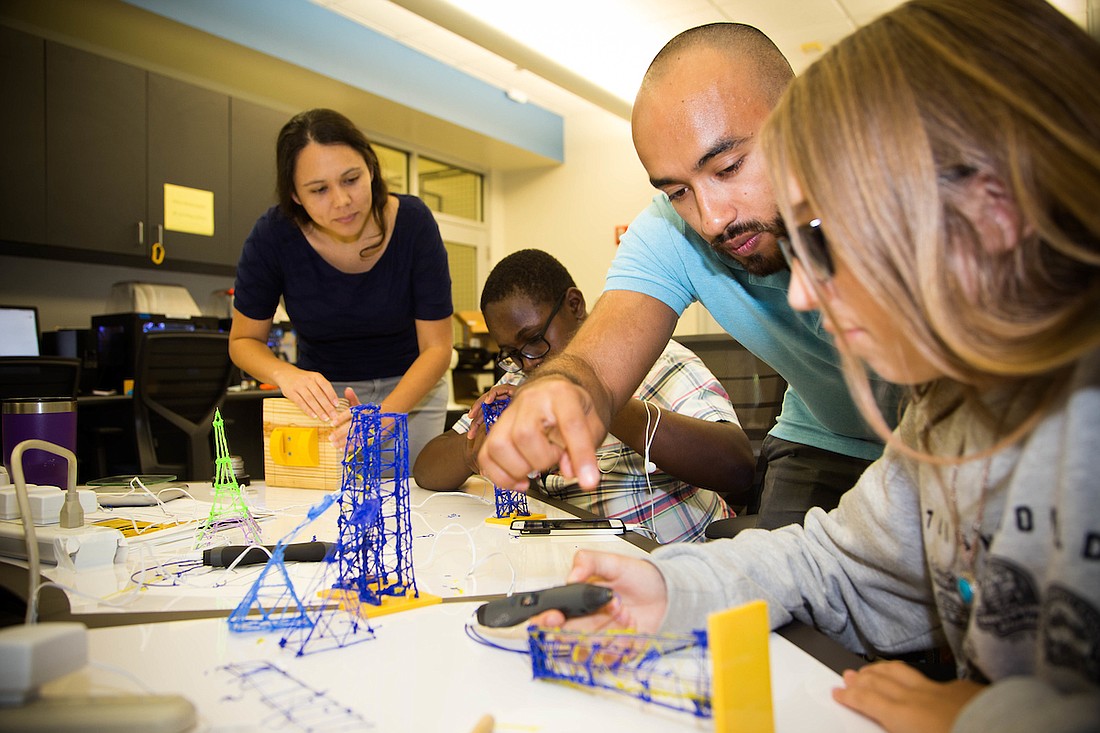- April 24, 2024
-
-
Loading

Loading

Middle and high school students from Port Orange and other Volusia County cities developed 3D-printed items as part of a summer camp that introduced the students to the different science, technology, engineering and mathematics fields.
The new Embry-Riddle Aeronautical University overnight camp had students working with the 3D program's creators, Juan Granizo and Cassandra Gribbins, who are alumni and visiting assistant professors with the Department of Engineering Fundamentals and who teach various classes during the year to Embry-Riddle students.
The 3D camp comes on the heels of the announcement that for the first time ever, a family in France would be moving into a 3D-printed home. But 3D printing has expanded not only across the globe but also in how it is used. At Embry-Riddle, some students have their own 3D printers in their dorms while mechanical engineering students working on this year’s Formula SAE car used 3D CAD software to construct parts of the vehicle. Embry-Riddle aerospace and mechanical engineering students also designed and 3D printed a small container that housed T-cells from mice that were exposed to microgravity aboard Blue Origin’s New Shepard Rocket in a suborbital flight last December.
During the students' time at camp, they used virtual reality modeling to learn about engineering and 3D modeling. They also had a chance to work in the university's advanced Makerspace Lab.
Gribbins, who runs the Makerspace Lab, said the activities allow the students to see their creativity come to life and understand how STEM is a part of many day-to-day facets.
“Since Embry-Riddle’s advanced Makerspace Lab started, we’ve had more than 300 print requests and multiple 3D scanning requests from not only the College of Engineering but also the College of Arts and Sciences and members from the Embry-Riddle Daytona Beach Campus community," Gribbins said. "Students and faculty have requested parts and scans for research.”
The students were able to develop items such as keychains and model-sized bridges using both 3D printing and 3D pens. Students were also given software to better understand and continue learning about 3D printing.
Both Lily Lehr, 13, of Port Orange, and Akhenaten Mswia, 13, of Griffin, Georgia, said they enjoyed being able to hold the three-dimensional objects that they had designed on a computer in their hands.
Granizo said he believes the Makerspace lab has a large potential to attract young minds into STEM with the use of 3D printers, 3D pens, 3D scanners, Virtual Reality software interaction and other tools. He said that is why he and Gribbins developed this camp — to reach the young community outside Embry-Riddle who may not have access to this type of technology and to increase their interest in science.
In total, there have been 150 campers, ages 13-18, who have been using the tools at the Makerspace Lab this summer. Granizo and Gribbins said they hope the summer camp can be expanded in the future to three weeks and include more middle and elementary school students.
Granizo said that the impact of 3D printing is broad and that there have been people from all departments, from freshmen to seniors and even graduate students, coming into the lab with printing requests or just asking for tips about the design-to-printing process. One example he gave was Embry-Riddle student Enrique Ayala, who, in conjunction with his team, modeled the turbocharger of a car using CATIA — a multi-platform software suite for computer-aided design. Since they re-designed the turbocharger in order to increase its efficiency, they 3D printed all the modified parts to be assembled all together. Enrique and his team won the EGR120 Graphical Communications poster contest as the most sophisticated design.
“I think 3D printing can change how manufacturing works all together,” said Xander Blunt, 16, of Panama City, who wants a career in designing aircraft.